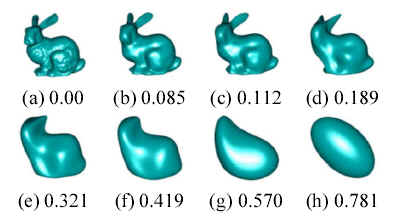Microsoft Research Asia
Zhejiang University
Microsoft Research
Microsoft Research Asia
IEEE CVPR 2003

In this paper, we propose a novel shape representation we call Directional Histogram Model (DHM). It captures the shape variation of an object and is invariant to scaling and rigid transforms. The DHM is computed by first extracting a directional distribution of thickness histogram signatures, which are translation invariant. We show how the extraction of the thickness histogram distribution can be accelerated using conventional graphics hardware. Orientation invariance is achieved by computing the spherical harmonic transform of this distribution. Extensive experiments show that the DHM is capable of high discrimination power and is robust to noise.

We have presented the Directional Histogram Model (DHM) to study the shape similarity problem of 3-D objects. This novel representation is based on the thickness variations with
different viewing directions. In each viewing direction, a histogram model for the thickness distribution is built. We also presented a new shape descriptor in matrix form which we call matrix descriptor.
A major advantage of the matrix descriptor is its invariance to the
transforms of scaling, translation, rotation, origin-symmetric and
mirroring. Just as important, the matrix descriptor is easy and fast to
compute using commercially-available graphics hardware, stable against
noise, and expressive enough to distinguish between different global shapes.
The invariance properties of the matrix descriptor makes it is highly
suitable for shape similarity measurement, and it produces reasonable shape
comparison results as experiments have shown.
There are two major limitations of the DHM: (1) it can only describe rigid shapes, and (2) it only captures the global shape. As a result of (1), non-rigid transformed versions of the object are deemed different. As a result of (2), local features cannot be represented and compared.
Future work include investigating means of extending the current formulation to handle the DHM¡¯s inability to handle non-rigid shapes and local features. In addition, it would be interesting to analytically predict how many directional samples would be sufficient for any given 3-D object. search of three-dimensional models using parameterized statistics.
-paper-
[ PDF 517 KB ] [ bib ]